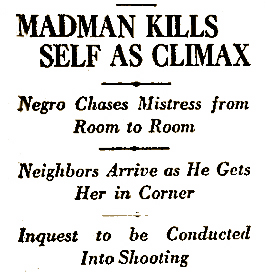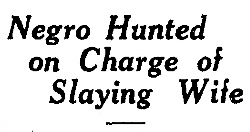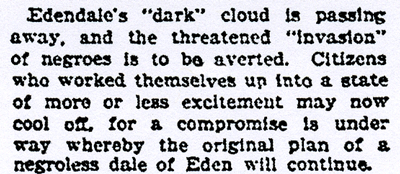
December 2, 1927
Hollywood
 Mrs. Margaret Pumphrey, 27, of the Milner Road Pumphreys, was standing in her bedroom of her hillside home, preparing to go downtown, when she was approached by her white-jacketed butler. He asked if there were any further orders. Mrs. Pumphrey said there were none.
Mrs. Margaret Pumphrey, 27, of the Milner Road Pumphreys, was standing in her bedroom of her hillside home, preparing to go downtown, when she was approached by her white-jacketed butler. He asked if there were any further orders. Mrs. Pumphrey said there were none.
With that, her servant—Richard R. Ewell, 30—developed an “insane gleam” in his eye and approached further…whereupon Mrs. Pumphrey noticed the .45 automatic in his hand.
The chase—and fusillade of shots—began! Mrs. Pumphey fled through a bathroom and into an adjoining bedroom, through a hallway and down the stairs, but there’s no running from the staff. They know the house better than you do.
The mad pursuit and firearm blasts continued from room to room to room until Margaret managed to lock herself into a downstairs bedroom. Ewell fired several shots into the door to break the lock, but once he heard the window open, he ran around the house to catch her escaping. And catch her he did—as he climbed into the window, he shot her in the side as she ran screaming out the door.
The screams alarmed neighbor Mrs. Johnstone, who came running (with her two maids in tow [also suitably armed?]) and Ewell fired upon them from the home’s entryway—but Ewell, realizing that the alarm had been raised and his game discovered, put the barrel to his head and sent his brains all over the foyer he’d kept so spotless the three months he’d been under the Pumphrey’s employ.
Mrs. Margaret Pumphrey (could Kaufman & Ryskind have scripted a name of greater puffery?) suffered more from shock and fright (as visions of FLW’s former servant surely flashed through her head) than from her injury; she was rushed to Hollywood Receiving and was treated for the superficial wound and released.
According to LeRoy Bird, with whom Ewell lived at 4307 Hooper Avenue, Philadelphia native Ewell was an industrious man of good character and habits and never had any previous trouble. Detective Lieutenant Mahoney contends that Ewell had probably been crazed by dope, especially as he’d been out the night before and had acted strangely in the morning.
Ewell leaves a widow, Inez Ewell, in Kansas City. Because his death was self-inflicted, there was no inquest over the body. A small notebook was later found in Ewell’s possessions, and it was greatly hoped by Captain of Detectives Slaughter to contain names of prominent Hollywood people and information about dope trafficking; but sadly for Slaughter, “the only names in the book, the officer declares, are those of negresses and it is devoid of anything referring to narcotics or trade in the drugs.”
So why did Richard Ewell snap? If only we had some sign.
 Despite there being a chance for a difference—Adams steadily asserted that the woman committed suicide—on October 12, 1925 it took a Los Angeles jury a record twenty-five minutes to send him to the gallows. (This being in part or wholly dependent on Adams’ race seems obvious—writ large as he’s routinely described as the “giant negro,” a term of which Times seems unusually fond.)
Despite there being a chance for a difference—Adams steadily asserted that the woman committed suicide—on October 12, 1925 it took a Los Angeles jury a record twenty-five minutes to send him to the gallows. (This being in part or wholly dependent on Adams’ race seems obvious—writ large as he’s routinely described as the “giant negro,” a term of which Times seems unusually fond.)

 Mrs. Margaret Pumphrey, 27, of the
Mrs. Margaret Pumphrey, 27, of the 



